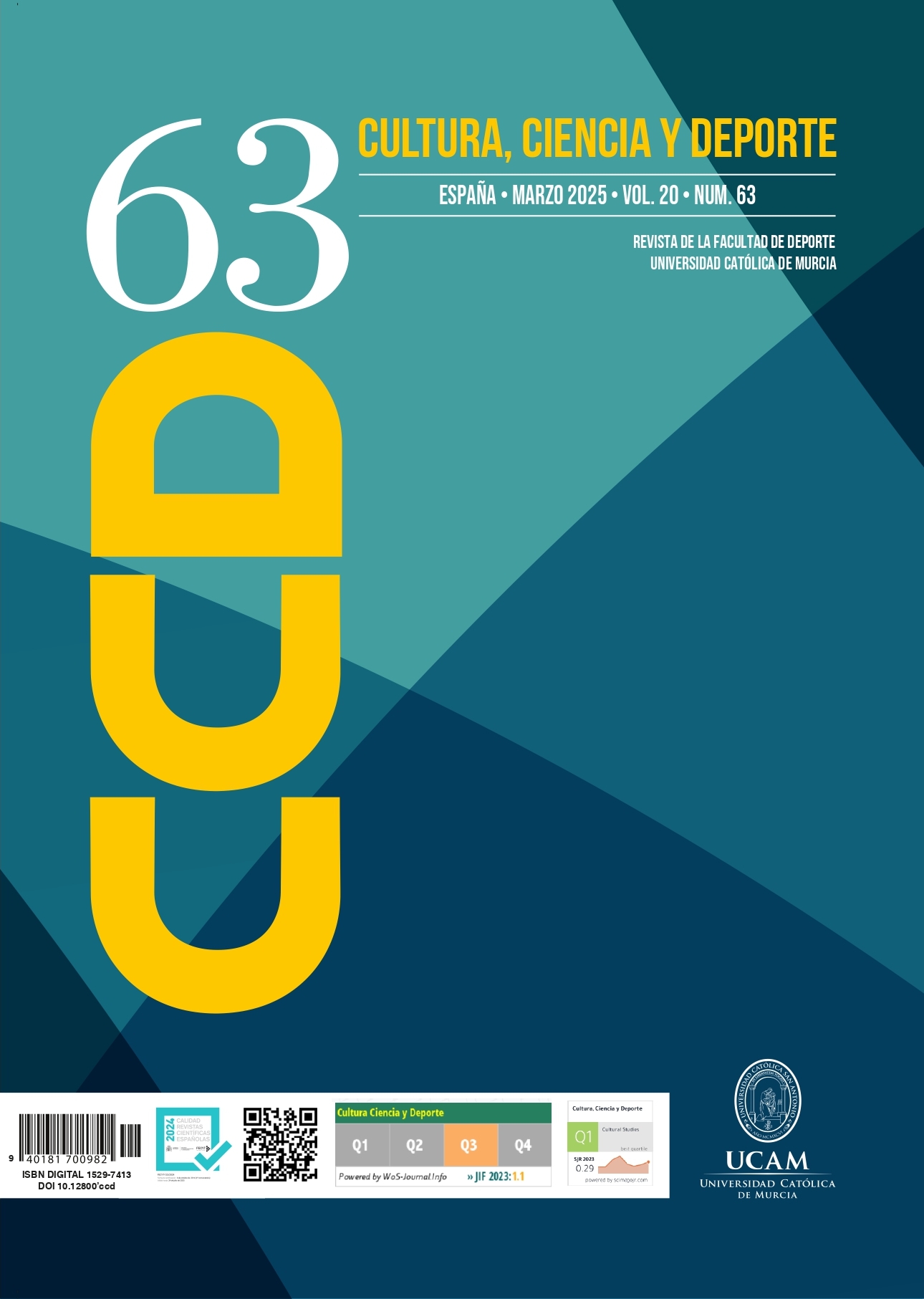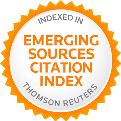Entrenamiento Muscular Inspiratorio en Modalidades Deportivas Cíclicas: Una Revisión Sistemática
DOI:
https://doi.org/10.12800/ccd.v20i63.2230Resumen
Se ha demostrado que el entrenamiento de los músculos inspiratorios impacta positivamente en el rendimiento de los deportes acíclicos, sin embargo, no se ha realizado una revisión que presente estos mismos cambios en los deportes cíclicos. Esta revisión sistemática tuvo como objetivo determinar el efecto del entrenamiento de los músculos inspiratorios en deportes cíclicos e identificar el impacto sobre la capacidad aeróbica, la fuerza de los músculos respiratorios y la función
pulmonar. Se realizó una búsqueda avanzada en las bases de datos de Web of Science, PubMed, Scopus, PEDro, ScienceDirect, OXFORD, LILACS, Taylor & Francis Group, Springer y SciELO, según PRISMA (Preferred Reporting Items for Systematic Reviews and Meta-Analyses). De 15.710 estudios identificados en las bases de datos, doce de ellos cumplieron con los criterios de elegibilidad para la revisión final. Mostrando mejoras significativas en el flujo espiratorio durante la espiración forzada desde la inspiración máxima, la Presión Inspiratoria Máxima y en el volumen espiratorio forzado máximo en el primer
segundo, tal como fueron evaluados antes y después del entrenamiento. Además, se evidenciaron cambios significativos en aquellos grupos que usaron dispositivos de resistencia que en aquellos que no usaron ningún dispositivo o placebo. En conclusión, el entrenamiento de los músculos inspiratorios con un mínimo de cuatro semanas de entrenamiento, al menos seis días a la semana y acompañado de fortalecimiento de los músculos centrales o core, evidencian efectos positivos sobre
la función pulmonar, fuerza muscular respiratoria y capacidad aeróbica en los deportes cíclicos.
Citas
Amonette, W., & Dupler, T. (2002). Efectos del Entrenamiento de los Músculos Respiratorios sobre el VO2máx., el Umbral Ventilatorio y la Función Pulmonar [Effects of Respiratory Muscle Training on VO2max, Ventilatory threshold and Pulmonary Function]. PubliCE.
Antonelli, C. B. B., Hartz, C. S., Santos, S. da S., & Moreno, M. A. (2020). Effects of inspiratory muscle training with progressive loading on respiratory muscle function and sports performance in high-performance wheelchair basketball athletes: A randomized clinical trial. International Journal of Sports Physiology and Performance, 15(2), 238–242. https://doi.org/10.1123/ijspp.2018-0979
Archiza, B., Andaku, D. K., Caruso, F. C. R., Bonjorno, J. C., Jr, Oliveira, C. R. de, Ricci, P. A., Amaral, A. C. do, Mattiello, S. M., Libardi, C. A., Phillips, S. A., Arena, R., & Borghi-Silva, A. (2018). Effects of inspiratory muscle training in professional women football players: a randomized sham-controlled trial. Journal of Sports Sciences, 36(7), 771–780. https://doi.org/10.1080/02640414.2017.1340659
Barker, T. H., Stone, J. C., Sears, K., Klugar, M., Tufanaru, C., Leonardi-Bee, J., Aromataris, E., & Munn, Z. (2023). The revised JBI critical appraisal tool for the assessment of risk of bias for randomized controlled trials. JBI Evidence Synthesis, 21(3), 494–506. https://doi.org/10.11124/JBIES-22-00430
Boussana, A., Galy, O., Le Gallais, D., & Hue, O. (2020). The effect of an Olympic distance triathlon on the respiratory muscle strength and endurance in triathletes. Journal of Exercise Rehabilitation, 16(4), 356–362. https://doi.org/10.12965/jer.2040518.259
Boussana, A., Matecki, S., Galy, O., Hue, O., Ramonatxo, M., & Le Gallais, D. (2001). The effect of exercise modality on respiratory muscle performance in triathletes. Medicine and Science in Sports and Exercise, 33(12), 2036–2043. https://doi.org/10.1097/00005768-200112000-00010
Brown, S., & Kilding, A. E. (2011). Exercise-induced inspiratory muscle fatigue during swimming: the effect of race distance. Journal of Strength and Conditioning Research, 25(5), 1204–1209. https://doi.org/10.1519/JSC.0b013e3181d67ab8
Cahill, G., & MacNamara, Á. (2024). Contextual factors in sport talent identification research. Sport in Society, 27(7), 1180–1216. https://doi.org/10.1080/17430437.2023.2288149
Casas, A. (2008). Fisiología y metodología del entrenamiento de resistencia intermitente para deportes acíclicos [Physiology and methodology of intermittent resistance training for acyclic sports]. Revista de Deporte y Ejercicio Humanos, 3(1), 23–52. https://doi.org/10.4100/jhse.2008.31.03
Chang, Y.-C., Chang, H.-Y., Ho, C.-C., Lee, P.-F., Chou, Y.-C., Tsai, M.-W., & Chou, L.-W. (2021). Effects of 4-week inspiratory muscle training on sport performance in college 800-meter track runners. Medicina (Kaunas, Lithuania), 57(1), 72. https://doi.org/10.3390/medicina57010072
Chuanye, H., & Hua, L. (2010). The effect of dyspnea on badminton players’ performance. Journal of Jilin Institute of Physical Education, 6.
De Sousa, M. M., Pimentel, M. D. S., Sobreira, I. de A., Barros, R. de J., Borghi-Silva, A., & Mazzoli-Rocha, F. (2021). Inspiratory muscle training improves aerobic capacity in amateur indoor football players. International Journal of Sports Medicine, 42(5), 456–463. https://doi.org/10.1055/a-1255-3256
Fabero-Garrido, R., Del Corral, T., Angulo-Díaz-Parreño, S., Plaza-Manzano, G., Martín-Casas, P., Cleland, J. A., Fernández-de-Las-Peñas, C., & López-de-Uralde-Villanueva, I. (2022). Respiratory muscle training improves exercise tolerance and respiratory muscle function / structure post-stroke at short term: A systematic review and meta-analysis. Annals of physical and rehabilitation medicine, 65(5), 101596. https://doi.org/10.1016/j.rehab.2021.101596
Fernández, J. F. (2012). El entrenamiento de alta intensidad, una herramienta para la mejora del rendimiento en los deportes de perfil intermitente [High intensity training, a tool for improving performance in intermittent sports. Revista de Entrenamiento Deportivo, 26(2), 5–14.
Forbes, S., Game, A., Syrotuik, D., Jones, R., & Bell, G. J. (2011). The effect of inspiratory and expiratory respiratory muscle training in rowers. Research in Sports Medicine, 19(4), 217–230. https://doi.org/10.1080/15438627.2011.608033
Gómez-Albareda, E., Viscor, G., & García, I. (2023). Inspiratory muscle training improves maximal inspiratory pressure without increasing performance in elite swimmers. International Journal of Sports Physiology and Performance, 18(3), 320–325. https://doi.org/10.1123/ijspp.2022-0238
Griffiths, L. A., & McConnell, A. K. (2007). The influence of inspiratory and expiratory muscle training upon rowing performance. European Journal of Applied Physiology, 99(5), 457–466. https://doi.org/10.1007/s00421-006-0367-6
HajGhanbari, B., Yamabayashi, C., Buna, T. R., Coelho, J. D., Freedman, K. D., Morton, T. A., Palmer, S. A., Toy, M. A., Walsh, C., Sheel, A. W., & Reid, W. D. (2013). Effects of respiratory muscle training on performance in athletes: a systematic review with meta-analyses. Journal of Strength and Conditioning Research, 27(6), 1643–1663. https://doi.org/10.1519/JSC.0b013e318269f73f
Higgins, J. P., & Green, S. (2008). Cochrane handbook for systematic reviews. The Cochrane Collaboration.
Holm, P., Sattler, A., & Fregosi, R. F. (2004). Endurance training of respiratory muscles improves cycling performance in fit young cyclists. BMC Physiology, 4(1), 9. https://doi.org/10.1186/1472-6793-4-9
Kowalski, T., Kasiak, P. S., Rebis, K., Klusiewicz, A., Granda, D., & Wiecha, S. (2023). Respiratory muscle training induces additional stress and training load in well-trained triathletes-randomized controlled trial. Frontiers in Physiology, 14, 1264265. https://doi.org/10.3389/fphys.2023.1264265
Lemaitre, F., Coquart, J. B., Chavallard, F., Castres, I., Mucci, P., Costalat, G., & Chollet, D. (2013). Effect of additional respiratory muscle endurance training in young well-trained swimmers. Journal of Sports Science & Medicine, 12(4), 630–638.
Lorca-Santiago, J., Jiménez, S. L., Pareja-Galeano, H., & Lorenzo, A. (2020). Inspiratory muscle training in intermittent sports modalities: A systematic review. International Journal of Environmental Research and Public Health, 17(12), 4448. https://doi.org/10.3390/ijerph17124448
Manchado-Gobatto, F. B., Torres, R. S., Marostegan, A. B., Rasteiro, F. M., Hartz, C. S., Moreno, M. A., Pinto, A. S., & Gobatto, C. A. (2022). Complex network model reveals the impact of inspiratory muscle pre-activation on interactions among physiological responses and muscle oxygenation during running and passive recovery. Biology, 11(7), 963. https://doi.org/10.3390/biology11070963
Mickleborough, T. D., Stager, J. M., Chatham, K., Lindley, M. R., & Ionescu, A. A. (2008). Pulmonary adaptations to swim and inspiratory muscle training. European Journal of Applied Physiology, 103(6), 635–646. https://doi.org/10.1007/s00421-008-0759-x
Moseley, A. M., Elkins, M. R., Van der Wees, P. J., & Pinheiro, M. B. (2020). Using research to guide practice: The Physiotherapy Evidence Database (PEDro). Brazilian Journal of Physical Therapy, 24(5), 384–391. https://doi.org/10.1016/j.bjpt.2019.11.002
Nunes Júnior, A. de O., Donzeli, M. A., Shimano, S. G. N., de Oliveira, N. M. L., Ruas, G., & Bertoncello, D. (2018). Efectos del entrenamiento muscular inspiratorio de alta intensidad en jugadores de rugby. [Effects of high-intensity inspiratory muscle training in rugby players]. Revista Brasileira de Medicina do Esporte, 24(3), 216–219.
Okrzymowska, P., Kurzaj, M., Seidel, W., & Rożek-Piechura, K. (2019). Eight weeks of inspiratory muscle training improves pulmonary function in disabled swimmers-A randomized trial. International Journal of Environmental Research and Public Health, 16(10), 1747. https://doi.org/10.3390/ijerph16101747
Page, M. J., McKenzie, J. E., Bossuyt, P. M., Boutron, I., Hoffmann, T. C., Mulrow, C. D., Shamseer, L., Tetzlaff, J. M., Akl, E. A., Brennan, S. E., Chou, R., Glanville, J., Grimshaw, J. M., Hróbjartsson, A., Lalu, M. M., Li, T., Loder, E. W., Mayo-Wilson, E., McDonald, S., … Moher, D. (2021). The PRISMA 2020 statement: an updated guideline for reporting systematic reviews. Systematic Reviews, 10(1), 89. https://doi.org/10.1186/s13643-021-01626-4
Physical Therapist Practice. (2023). American Physical Therapy Association.
Romer, L. M., Lovering, A. T., Haverkamp, H. C., Pegelow, D. F., & Dempsey, J. A. (2006). Effect of inspiratory muscle work on peripheral fatigue of locomotor muscles in healthy humans: Inspiratory muscle work and locomotor muscle fatigue. The Journal of Physiology, 571(Pt 2), 425–439. https://doi.org/10.1113/jphysiol.2005.099697
Stanojevic, S., Kaminsky, D. A., Miller, M. R., Thompson, B., Aliverti, A., Barjaktarevic, I., Cooper, B. G., Culver, B., Derom, E., Hall, G. L., Hallstrand, T. S., Leuppi, J. D., MacIntyre, N., McCormack, M., Rosenfeld, M., & Swenson, E. R. (2022). ERS/ATS technical standard on interpretive strategies for routine lung function tests. The European Respiratory Journal, 60(1), 2101499. https://doi.org/10.1183/13993003.01499-2021
Tan, M., Liang, Y., Lv, W., Ren, H., & Cai, Q. (2023). The effects of inspiratory muscle training on swimming performance: A study on the cohort of swimming specialization students. Physiology & Behavior, 271(114347). https://doi.org/10.1016/j.physbeh.2023.114347
Tong, T. K., Fu, F. H., Eston, R., Chung, P.-K., Quach, B., & Lu, K. (2010). Chronic and acute inspiratory muscle loading augment the effect of a 6-week interval program on tolerance of high-intensity intermittent bouts of running. Journal of Strength and Conditioning Research, 24(11), 3041–3048. https://doi.org/10.1519/JSC.0b013e3181bf033b
Tong, T. K., McConnell, A. K., Lin, H., Nie, J., Zhang, H., & Wang, J. (2016). “functional” inspiratory and core muscle training enhances running performance and economy. Journal of Strength and Conditioning Research, 30(10), 2942–2951. https://doi.org/10.1519/JSC.0000000000000656
Tsvetkova-Gaberska, M., Kozhuharov, M., Ganeva, M., Markova, P., & Pencheva, N. (2023). The effect of respiratory muscle training on young track-and-field athletes. Journal of Physical Education and Sport, 23(3), 730–737. https://doi.org/10.7752/jpes.2023.03090
Walter, J. S., Wurster, R. D., Zhu, Q., Staunton, C., & Laghi, F. (2010). Stimulating multiple respiratory muscles with intramuscular Permaloc electrodes. The Journal of Spinal Cord Medicine, 33(2), 135–143. https://doi.org/10.1080/10790268.2010.11689688
Wells, G. D., Plyley, M., Thomas, S., Goodman, L., & Duffin, J. (2005). Effects of concurrent inspiratory and expiratory muscle training on respiratory and exercise performance in competitive swimmers. European Journal of Applied Physiology, 94(5–6), 527–540. https://doi.org/10.1007/s00421-005-1375-7
Williams, J. S., Wongsathikun, J., Boon, S. M., & Acevedo, E. O. (2002). Inspiratory muscle training fails to improve endurance capacity in athletes. Medicine and Science in Sports and Exercise, 34(7), 1194–1198. https://doi.org/10.1097/00005768-200207000-00022
Descargas
Publicado
Cómo citar
Número
Sección
Licencia
Derechos de autor 2025 Creative Commons Attribution License

Esta obra está bajo una licencia internacional Creative Commons Atribución-NoComercial-CompartirIgual 4.0.
Los autores que publican en esta revista están de acuerdo con los siguientes términos:- Los autores conservan los derechos de autor y garantizan a la revista el derecho de ser la primera publicación del trabajo al igual que licenciado bajo una Creative Commons Attribution License que permite a otros compartir el trabajo con un reconocimiento de la autoría del trabajo y la publicación inicial en esta revista.













